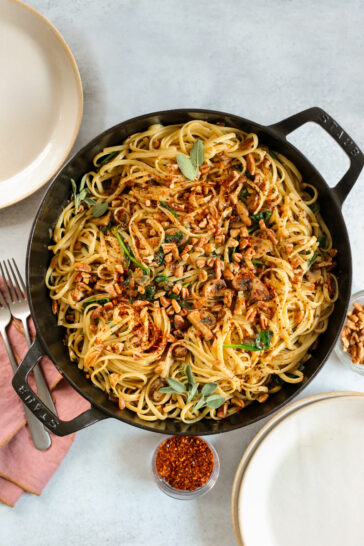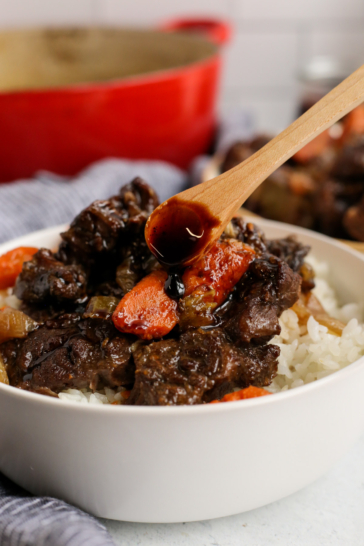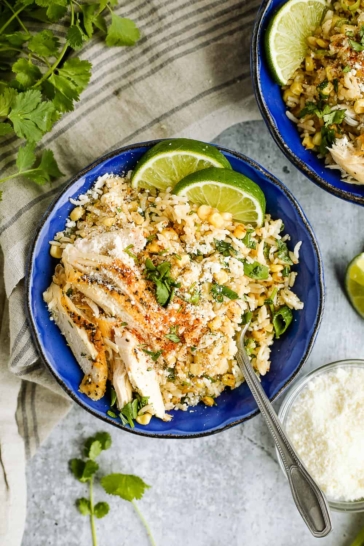When you’re ready to quit diets for good and get started with intuitive eating, save this post! It’s easier said than done to leave the diet mentality behind you. Especially when diet culture is constantly evolving and showing up in subtle ways. These are the top five intuitive eating mistakes I see as a non-diet registered dietitian, plus tips on how to avoid and overcome them.

As an anti-diet registered dietitian, I’ve spent most of my career helping people heal their relationship with food after bidding farewell to diets forever. However, I’ve noticed some common pitfalls that individuals often encounter on their intuitive eating journey.
In this blog post, I will shed light on the most prevalent mistakes people make when leaving diets behind and provide insights on how to avoid them.
If you’re already familiar with intuitive eating and a non-diet approach, feel free to skip ahead using the links in the table of contents below.
Here’s What I’ll Cover In This Post
But if you’re new to intuitive eating, let’s start with a brief introduction.
What Is Intuitive Eating?
Intuitive eating (IE) is, in the simplest terms, the opposite of dieting for weight loss. That’s obviously a very over-simplified definition, but try to think of it as an approach to eating for reasons other than weight loss. Gentle nutrition is still a part of it. After all, IE can be used to improve physical health. But it doesn’t come at the expense of your emotional or mental health.
IE was developed by dietitians Evelyn Tribole and Elyse Resch in the 1990s. The first edition of the book, “Intuitive Eating” actually did make some references to weight loss. But I think that was a sign of the times, as it really went against the status quo for diet books of the day.
By the mid-2010s more and more people were familiar with the concept of IE. And just recently within the past few years, it’s become a trend as more and more people openly declare themselves to be an “intuitive eater.”
What’s Intuitive Eating Really About?
Contrary to popular belief, there’s much more to IE than just eating everything in moderation. Or, another common misconception is that you should simply eat when you’re hungry and stop when you’re full.
In reality, IE is a structured framework of 10 principles. They include concepts such as making peace with food, challenging the food police, tuning into hunger and fullness cues, discovering the satisfaction factor (probably my favorite intuitive eating principle), and more.
It’s certainly a different approach to health and wellness, especially compared to fad diets or restrictive dieting. While they’re often framed as healthy habits, these strategies are a slippery slope and can morph into disordered eating.
That’s a topic for another day, though. Because another slippery slope is the one that happens when you think you’re done with dieting…yet it still shows up in small, sneaky ways.
Keep reading to learn about the biggest mistakes I see with new intuitive eaters. These habits can hold you back from truly moving past the dieting mentality for good.
If you want to learn more about the long and harmful history of the diet industry, check out my list of the best books for your anti-diet bookshelf.
Mistake #1: The Trap of “Good” and “Bad” Food Labels
One of the initial stumbling blocks is the use of labels like “good” or “bad,” along with phrases such as “guilty pleasures,” “indulgences,” or describing food as “junk.”
These labels are a sign of binary thinking, automatically triggering thoughts of what you “should” or “should not” consume. The reality, however, is not nearly so simple. It’s essential to recognize the nuance in how we perceive food, considering factors like convenience, budget, and personal preferences. Not to mention other factors like privilege, environment, genetics, and more.
As I sometimes describe it, instead of black & white, all-or-nothing thinking, it’s more like a mixed and messy paint tray of colors that can change depending on the situation. It’s not as simple or easy as abiding by strict and rigid food rules. But it does allow for flexibility and discernment.
How to Avoid Mistake #1
- Take an audit of your vocabulary. Take some time to reflect on the words and phrases you commonly use to describe food. Are they judgmental or indicative of shame or guilt? What could you replace them with that feels more neutral or inclusive?
- Challenge your beliefs about food. This one isn’t easy, as our beliefs are often shaped by our environment, significant people in our lives, and past experiences or what we’ve learned through the years. If you’re ready to get curious, start to question whether these beliefs about food and eating actually hold up under critique. For example, has it ever been as simple as “eat less, move more” to improve health? Could one person’s “bad” or “unhealthy” food be perfectly fine for someone else?
- Slow down and stay curious. Diet culture thrives when we move too fast to pause and reflect. And don’t be too hard on yourself if you still find yourself falling into old assumptions from time to time. What’s more important is what comes after that initial thought, where you ask yourself, “Is this really what I believe to be true?”
Trust me, this habit is a hard one to break. This “good food/bad food” binary is reinforced in the media and pop culture, as well as everyday conversations and interactions, so it may take a lot of time before you can actively tune it out. But trust me again when I say, it can be done and you’ll be amazed at how easy it is to ignore once you start to describe food in other ways.
Mistake #2: Tracking Apps and Calorie Counting
Ok, this next time is major: if you’re using a non-diet approach, it’s probably a mistake to keep using your food tracking apps and counting calories or macros.
Hear me out. Because yes, I know there’s a time and a place where this can be helpful. When I worked in a clinical setting, we used these tools all the time so our patients with Type 1 diabetes could more easily calculate how many carbs were in their meals. But the need to accurately dose insulin is very different than the desire to micromanage each bite of food.
If you’ve been dieting anytime since smart phones burst onto the scene, you’re probably no stranger to these tracking apps. Maybe MyFitness Pal or LoseIt! has had a permanent spot on your menu screen for years.
But continuing to use these apps is totally contradictory to the principles of intuitive eating. When you use the apps to control how much or what you eat, it’s a form of restriction.
And it may happen consciously or unconsciously. But focusing on the numbers can take you out of the present or distract from reconnecting to hunger and fullness cues. Not to mention, they’re rarely accurate. Some of the data may be user-generated or incomplete. Plus, we as humans are notoriously bad at accurately estimating portions sizes or volume.
How to Avoid Mistake #2
This isn’t about making you feel like you’re doing something “wrong.” Remember how we just talked about more neutrality, less judgment? This is what I recommend trying if you’re willing to experiment with not tracking everything you eat anymore.
- Delete the apps. Yes, I’m sorry. But it’s time to rip off the bandaid and (at the very least) try a trial period of eating without tracking or relying on these apps.
- Embrace uncertainty and get comfortable being uncomfortable. Because yes, that first meal or snack that you don’t rush off to enter in the app is going to feel weird at best, maybe downright anxiety-inducing and stressful at worst. But this is part of the process. At one point in time, everyone ate without the aid of technology, and you can, too. It’s OK to admit you’d rather have the sense of safety these apps can bring, but getting comfortable with the discomfort can eventually help you be more present as you eat to cultivate body trust.
- Imagine what food freedom feels like. Everyone’s version of this will look different, but I challenge you to imagine what it would be like to eat without knowing every little detail about the calories or nutrients in your food. How did you use that information in the past? Was it helpful? Was it limiting? Is it something you’re ready to leave behind?
Mistake #3: The Nutritious vs. Delicious Debate
This next mistake will sound a bit strange coming from a dietitian. But I think you’re holding yourself back if you always choose the most nutritious or seemingly “healthy” food available.
Don’t get it twisted. Nutrition still matters. In fact, Gentle Nutrition is the tenth and final principle of IE. But it comes last for a reason. Shifting the focus back to nutrition too early in the process can leave us in a sense of limbo.
In some ways, you’re past the diety stuff. Maybe your relationship with movement is in a better place, or emotional eating isn’t your only way to cope. But maybe you’re still feeling the pressure to always select the most nutritious option instead of what your taste buds are really calling out for.
This may not happen all the time, or in certain settings. But in my experience, it may be more likely to happen when there’s an audience.
For instance, you don’t feel this pressure to override your taste preferences when you’re grocery shopping alone, but when you’re at a restaurant with friends you order the kale salad instead of the burger. Or you feel comfortable eating what and how much you want when you’re with family, but at work or in public you make sure to monitor your meals. And it can be compounded if you’re in a large or fat body because everyone expects you to be making a constant effort to try to lose weight.
To me, this is part of the perfectionism and performance that often shows up with dieting. Diet culture promotes the idea that every meal should be packed with nutrients, leading to the substitution of enjoyable foods with so-called healthier alternatives.
This approach sacrifices satisfaction and pleasure in eating. It might look like eating a chocolate flavored or chocolate coated protein bar when you would rather have a soft and gooey chocolate chip cookie. Or buying the gluten-free chickpea pasta instead of regular pasta if you don’t need a gluten-free diet.
How to Avoid Mistake #3
To be very clear: you do not have to give this up if it helps you get by. Weight stigma is a real and harmful thing. If this helps you avoid unsolicited comments or derogatory remarks, let yourself eat a meal in peace.
But in a safer environment, you can experiment with breaking this habit by trying the following:
- Think about your taste preferences. Challenge yourself to come up with as many descriptive words as possible. Then sort through them and decide what feels most delicious and satisfying to you. Crispy vs. crunchy? Savory vs. spicy?
- Allow flexibility. More than you think you’ll need or use. This is the beauty of gentle nutrition. Because there’s no rule that says you have to eat something that doesn’t align with your taste preferences or individual nutrition needs. But beyond that, there’s enough flexibility for you to try new things, revisit foods you haven’t eaten in a while, or take it one bite at a time.
- Trust yourself. Meaning, trust that you already generally understand what’s healthy. The thing about nutrition is that while yes, it can be complex and complicated at times, there’s plenty of other times where it’s very simple. More fruits, vegetables, whole grains, enough protein and variety, and not overdoing it on any one thing (which includes everything from apples to alcohol).
Street Smart Nutrition Tip: The flip side of trusting yourself is acknowledging that it’s just a matter of time before you’re disappointed by a food choice. It’s OK to go for something that sounds amazing at the time, but if you take that first bite and it’s an underwhelming let down, that’s OK. Since we’re not harshly judging ourselves or berating that food choice, we can take it as a learning opportunity and the next time, we’ll remember if there are particular foods that just miss the mark for some reason.
Mistake #4: Using Weight As An Indicator of Health
At this point, this is probably second nature to the majority of people.
For far too long, we’ve been socialized to believe it’s impossible to be healthy if you’re fat and the best way to get, and stay, healthy is to lose weight.
But here’s the thing: there isn’t a single health condition, chronic or acute, that only affects people in fat bodies. Sit with that idea for a moment if this is new to you. Because whether we’re talking about an ear infection or heart disease or food allergies or cancer, there’s a chance it can happen to anyone, in any body.
So why do we attach so much significance to weight? It goes way, way back in history (I recommend reading “Fearing the Black Body” for more on this) when early beliefs about class, beauty, and body size were more closely tied to race than health. It was later that harmful stereotypes, medical bias, fat phobia, and systemic racism culminated into what we now see as the weight-centric “standard of care” in the present moment.
This is a big topic. There’s so much to critique about the current weight science, weight bias in the medical literature, and growing evidence to support a weight-neutral model or intuitive eating paradigm. I highly recommend the Weight and Healthcare substack by Ragen Chastain for more on this.
For now, I’ll keep it short and sweet. In order to fully move past a diet mindset, especially after years of chronic dieting in pursuit of weight loss for health, it’s important to separate the two.
How to Avoid Mistake #4
- Try a journaling exercise. Take some time to list actionable behaviors that can support self-care or promote health that have absolutely nothing to do with dieting. Think of things like, drinking enough water to stay hydrated, finding a form of joyful movement, connecting with friends and family, engaging in safe practices around alcohol, quitting smoking, going to therapy, getting a preventative screening, and the list goes on…. Get creative because this is a personal process. If it’s something that feels like it would be helpful for you that doesn’t involve dieting for weight loss, put it on your list!
- Challenge negative beliefs and stereotypes. It can be an emotional roller coaster to point out and confront long-held beliefs about weight and health. Especially if you’ve been subjected to criticism about your body size from an early age. But see if you can reflect on past experiences and identify patterns. For example, at what point in your life did you feel the most nourished, the most well? Was that at the same time you were at your lowest weight? And vice versa, was there anything going on when you were at your highest weight that impacted how you took care of yourself and your body?
- Start learning from diverse voices and experts using a weight-inclusive approach. Thankfully, social media makes this a little easier. But now is a good time to connect with healthcare professionals and everyday people who embody a weight-inclusive approach.
Street Smart Nutrition Tip: As you detangle the links between weight and health, it’s also important to detach weight from worth. Healthiest is a form of ableism that assumes a moral obligation to pursue good health or maintain good health. And no, that’s not a prerequisite for basic respect and dignity. It might be helpful to keep this in mind as you navigate a new way of thinking about health in the long term.
Mistake #5: Still Surrounded by Diet Talk
People often bond over shared experiences. And dieting is no different. I’m sure you can think of at least a few people in your close circle who are still entrenched in diet culture. This is a significant obstacle for intuitive eating in more ways than one.
First, you’re exposed to frequent (maybe even relentless) reminders of dieting. Some environmental things can’t really be avoided. Like a reference to dieting on a popular TV show or a commercial that plays above you in a public space. Over time, your resilience to this type of messaging will get stronger and eventually it won’t feel so inescapable.
But additionally, you might feel tension within some of your relationships with other people. Maybe it’s a close friend, a work colleague, or even an immediate family member. It can be tough to stick to your convictions and commitment to intuitive eating when you’re faced with invitations to rejoin a diet or if it keeps coming up in conversations. Food talk, body talk, discussions about workouts and exercise…where do you draw the line?
I’m not saying to cut all ties with important people in your life. However, I am saying you may need to establish a new “normal” that can support your shift away from dieting while still respecting their autonomy if they choose to stick with it.
How to Avoid Mistake #5
- Set boundaries. This can be incredibly difficult, especially if your dynamic hasn’t always involved establishing and maintaining boundaries. Take a moment to think about what you’re comfortable hearing about, or for how long. You can bring it up with them at a time when it’s calm instead of interrupting it in the moment.
- Redirect the conversation when you need to. This takes some practice. But it’s helpful to have a few pivots in your back pocket in case you need to use them. If the break room at work suddenly turns into a share-fest about weight loss plans for the new year, you’re going to want an exit strategy. It’s going to be awkward. The words will feel foreign. But the good news is that it gets easier with practice. Soon you’ll feel more comfortable and confident responding to diet talk and steering clear of it.
- Finally, seek support from like-minded folks. Like I mentioned earlier, there’s a time and a place for all things. Maybe in certain scenarios it’s not the right time to debate the merits of intuitive eating with someone. But you’re going to need someone in your corner. Sort of a soft place to land and retreat to and process what it is you need. If you have access to a weight-inclusive dietitians or a therapist trained as a certified intuitive eating counselor, that’s a great way to find support.
Remember that it’s probably not a question of if, but when, you’ll face these common pitfalls. That’s OK! It’s not a sign that you’re somehow failing at intuitive eating or that you’re doing it “wrong.”
Instead, try to be gentle with yourself and the emotions that are bound to get dredged up along the way. It’s not easy to flip the switch from restrictive diets to unconditional permission to eat.
Avoid these common traps by no longer moralizing food choices, abandoning tracking apps, embracing personal preferences, redefining health indicators, and setting boundaries in diet-centric relationships. This will help set you on the path to a better, and more sustainable, relationship with food, body image, and movement. Remember, the journey is different for everyone and the key is to offer yourself plenty of compassion along the way.
If you’re new to Intuitive Eating and want to learn more, check out these other posts:













